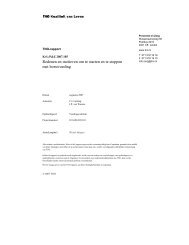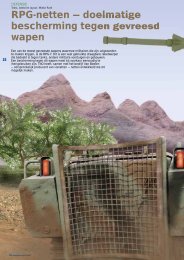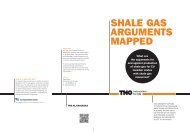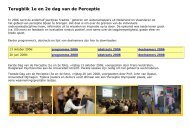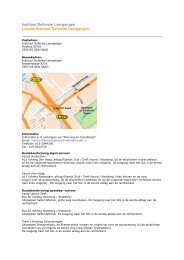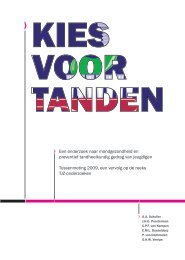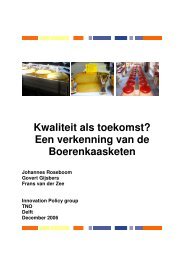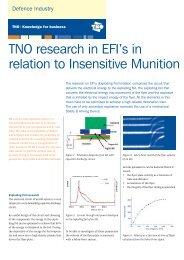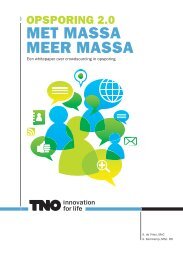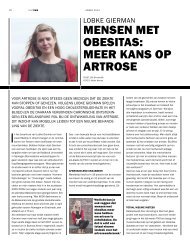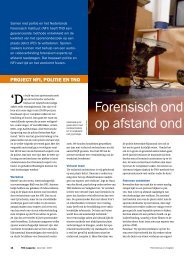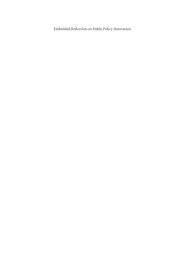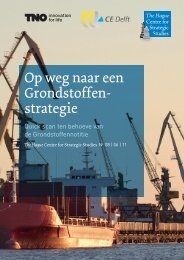Hinde r - TNO
Hinde r - TNO
Hinde r - TNO
Create successful ePaper yourself
Turn your PDF publications into a flip-book with our unique Google optimized e-Paper software.
<strong>TNO</strong> Inro rapport 2002-53<br />
Relaties tussen geluidbelasting en hinder voor industrie- en rangeerterreinen<br />
4 Relatie tussen geluidbelasting en hinder<br />
31 / 51<br />
Nadat de geluidgegevens (hoofdstuk 2) en de gegevens uit de enquête (hoofdstuk 3) zijn<br />
gekoppeld, is de relatie tussen geluidbelasting en hinder vastgesteld. Hierbij is ook<br />
aandacht gegeven aan andere voorspellers van geluidhinder dan Lden. De aanpak en<br />
resultaten worden hier beschreven. In de eerste paragraaf worden analysemodellen<br />
geïntroduceerd voor de beschrijving van de invloed van Lden en andere variabelen op<br />
hinder door geluid van industrie of rangeerterreinen. Deze paragraaf kan door de vooral<br />
inhoudelijk geïnteresseerde lezer worden overgeslagen. In de tweede paragraaf wordt de<br />
variatie in hinder tussen locaties onderzocht. Daarbij wordt nagegaan hoe deze variatie<br />
het best kan worden verdisconteerd in het analysemodel. De inhoudelijk meest<br />
interessante analyses komen in de derde, vierde en vijfde paragraaf aan de orde. De<br />
derde paragraaf gaat, behalve op de invloed van Lden op geluidhinder, in op de rol van<br />
persoons en situationele factoren. In de vierde paragraaf komt met name de invloed van<br />
specifieke kenmerken van de geluidsituatie op geluidhinder aan de orde. De vijfde<br />
paragraaf geeft voor het percentage erg gehinderden (%HA), percentage gehinderden<br />
(%A) en percentage minstens enigszins gehinderden (%LA) de relaties met Lden.<br />
4.1 Analysemodel<br />
Noise annoyance of an individual is translated to a scale from 0 to 100, and is denoted<br />
by A*ij (using individual index i and location index j). Instead of observing the<br />
individual noise annoyance A*ij precisely, it is only known for an individual in which<br />
interval on the scale from 0 to 100 A*ij comes. The locations of the boundaries of the<br />
intervals depend on the set of annoyance response categories used in a study. In this<br />
study the annoyance question has 11 response categories. Assuming equal intervals for<br />
the annoyance categories, this means that the boundaries on a 0-100 scale are 0, 9, 18,<br />
…, 82, 91, 100. We define a latent random variable A such that A* equals A if A∈<br />
[0,100], A* = 0 if A < 0, and A* = 100 if A > 100. Instead of modelling A* we model A.<br />
Aij is modelled as a linear combination of the noise exposure Lden and other predictor<br />
variables. Including random location and individual effects, the model is as follows:<br />
Aij = β0 + β1 Ldenij + β2 X2ij + .. + βΝ XNij + u0j + εij<br />
where u0j is a random location factor, normally distributed with zero mean and<br />
variance σ0 2 , and εij is normally distributed random individual ‘error’ term with<br />
mean zero and variance σ 2 . The variables X2ij ... XNij are predictor variables, such as<br />
type of dwelling or noise sensitivity, depending on the particular analysis. The two<br />
random variables u0j and εij are assumed to be independent. According to this model<br />
the relation between, on the one hand, Lden and the other predictor variables and, on<br />
the other hand, annoyance can have a different ‘intercept’ at each location. The<br />
average intercept is equal to β0. The total random component in model is equal to<br />
u0j + εij. This means that the observations within one location are not independent.<br />
Without a location effect the model becomes:<br />
Aij = β0 + β1 Ldenij + β2 X2ij + ... + βΝ XNij + εij.<br />
where u0j, the random location factor, has been omitted so that now all random<br />
variation is represented by εij. In the next section it will be investigated whether the




